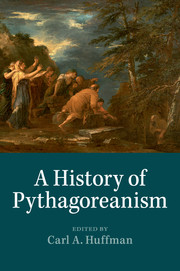Book contents
- Frontmatter
- Contents
- Contributors
- Abbreviations
- Introduction
- Chapter 1 Pythagoras
- Chapter 2 Philolaus
- Chapter 3 Archytas
- Chapter 4 Sixth-, fifth- and fourth-century Pythagoreans
- Chapter 5 The Pythagorean society and politics
- Chapter 6 The Pythagorean way of life and Pythagorean ethics
- Chapter 7 Pythagoreans, Orphism and Greek religion
- Chapter 8 The problem of Pythagorean mathematics
- Chapter 9 Pythagorean harmonics
- Chapter 10 The Pythagoreans and Plato
- Chapter 11 Aristotle on the “so-called Pythagoreans”: from lore to principles
- Chapter 12 Pythagoreanism in the Academic tradition: the Early Academy to Numenius
- Chapter 13 The Peripatetics on the Pythagoreans
- Chapter 14 Pythagoras in the historical tradition: from Herodotus to Diodorus Siculus
- Chapter 15 The pseudo-Pythagorean writings
- Chapter 16 Pythagoreans in Rome and Asia Minor around the turn of the common era
- Chapter 17 Diogenes Laertius’ Life of Pythagoras
- Chapter 18 Porphyry's Life of Pythagoras
- Chapter 19 Iamblichus’ On the Pythagorean Life in context
- Chapter 20 Pythagoras and Pythagoreanism in late antiquity and the Middle Ages
- Chapter 21 Pythagoras in the Early Renaissance
- Bibliography
- General index
- Index locorum
- Greek index
Chapter 20 - Pythagoras and Pythagoreanism in late antiquity and the Middle Ages
Published online by Cambridge University Press: 05 May 2014
- Frontmatter
- Contents
- Contributors
- Abbreviations
- Introduction
- Chapter 1 Pythagoras
- Chapter 2 Philolaus
- Chapter 3 Archytas
- Chapter 4 Sixth-, fifth- and fourth-century Pythagoreans
- Chapter 5 The Pythagorean society and politics
- Chapter 6 The Pythagorean way of life and Pythagorean ethics
- Chapter 7 Pythagoreans, Orphism and Greek religion
- Chapter 8 The problem of Pythagorean mathematics
- Chapter 9 Pythagorean harmonics
- Chapter 10 The Pythagoreans and Plato
- Chapter 11 Aristotle on the “so-called Pythagoreans”: from lore to principles
- Chapter 12 Pythagoreanism in the Academic tradition: the Early Academy to Numenius
- Chapter 13 The Peripatetics on the Pythagoreans
- Chapter 14 Pythagoras in the historical tradition: from Herodotus to Diodorus Siculus
- Chapter 15 The pseudo-Pythagorean writings
- Chapter 16 Pythagoreans in Rome and Asia Minor around the turn of the common era
- Chapter 17 Diogenes Laertius’ Life of Pythagoras
- Chapter 18 Porphyry's Life of Pythagoras
- Chapter 19 Iamblichus’ On the Pythagorean Life in context
- Chapter 20 Pythagoras and Pythagoreanism in late antiquity and the Middle Ages
- Chapter 21 Pythagoras in the Early Renaissance
- Bibliography
- General index
- Index locorum
- Greek index
Summary
Introduction and overview
Pitagoras, id est non indigens interrogationis vel interrogationis cumulus. ΠΥΘΟC enim interrogatio, ΑΓΟΡΑ cumulus.
Pythagoras, i.e., one who needs no questioning, or the culmination of questioning. For ΠΥΘΟC means questioning, ΑΓΟΡΑ means culmination.
This creative etymology, variations on which are employed by Carolingian scholars to annotate (or “gloss”) mentions of Pythagoras in both Boethius’ Fundamentals of Music (De institutione musica) and Martianus Capella's On the Marriage of Philology and Mercury (De nuptiis Philologiae et Mercurii), neatly encapsulates the medieval use of Pythagoras. In line with a tradition long established in the late ancient Latin texts that provided exclusive access to “Pythagorean” teachings, the medieval Pythagoras functioned as a “first principle”: to invoke his authority was to invoke the icon of Greek wisdom traditions. This gloss's etymological assertion of Pythagorean authority resonates with late ancient and medieval accounts of Pythagoras and the Pythagoreans on multiple levels. First, it well accords with the method of instruction ascribed to the Pythagoreans. According to Boethius, “it was customary for the Pythagoreans, whenever Master Pythagoras said something, that no one thereafter dare to challenge his reasoning; rather the reasoning of the teacher was their authority” (Inst. mus. 1.33 [223.4–7 Friedlein]; cf. Valerius Maximus 8.15.ext.1). By the twelfth century, this account of the Pythagorean method of instruction (Pythagorica doctrina) had codified into a supposed imposition of seven years of silence “according to the number of the seven liberal arts” (as Hugh of St. Victor explains: Didascalicon 3.3), during which Pythagorean disciples were allowed only to listen and believe; not until the eighth year were they allowed to broach questions (William of Conches Dragmaticon 1.1.3). Second, it echoes the common view of Pythagoras as both the inaugurator of the Greek philosophical tradition and its consummate practitioner, a view exemplified by Boethius’ equation of “Pythagorean knowledge” (scientia Pythagorica) with “perfect teaching” (perfecta doctrina: On the Categories 160B; see Ebbesen 1990: 387–91; Asztalos 1993: 379–88), a loftier mode of philosophizing suited only to those who have already mastered the beginning and intermediate stages of philosophy.
Keywords
Information
- Type
- Chapter
- Information
- A History of Pythagoreanism , pp. 416 - 434Publisher: Cambridge University PressPrint publication year: 2014
Accessibility standard: Unknown
Why this information is here
This section outlines the accessibility features of this content - including support for screen readers, full keyboard navigation and high-contrast display options. This may not be relevant for you.Accessibility Information
- 2
- Cited by
